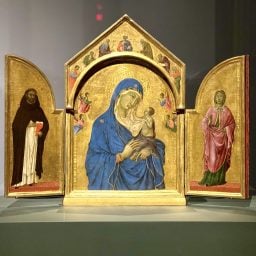During the renovation of its Fifth Avenue home, the famed Frick Collection has temporarily become the Frick Madison, transporting a cargo of its European Old Master treasures a few blocks north and one block east, to be presented in the Brutalist environs of the Whitney Museum’s old Marcel Breuer-designed building. It looks great. Bellini and Veronese, Vermeer and Ingres are given lots of room to breathe, their immemorial delicacies popping against the severe background of the Breuer. Porcelains and bronze figurines, usually given a more subordinate place at the Frick mansion, are also set off in a new kind of way against all that clean, empty space.
The results are a museum-lover’s dream—as in, I could literally imagine a certain kind of museum-lover having this exact dream: there I was, in the old Whitney building, but it was the art from the Frick, and it all felt so natural… The curators have talked about hoping that the new kind of space might attract a fresh kind of audience, but in some ways the ideal audience is someone who is familiar with the art already, and can revel in the subtle experience of seeing old friends in a novel way.
To me, the Frick Madison experiment is an invitation to consider what I want to get out of the museum in the first place, particularly at a moment when my engagement with art has been mainly digital for close to a year, surfing the infinite scroll of online art images, crawling the halls of digital museum visits.
Most people who have been through an art theory class know Walter Benjamin’s idea about the “decay of the aura” from his essay “The Work of the Art in the Age of Mechanical Reproduction”: that the mediation of film and photography cause us to treat artworks in a different, less reverential way, devaluing the original object. But I find it’s often misunderstood just how the museum fits into Benjamin’s theory. You might assume that seeing objects in the museum represents the quintessential experience of “aura”—but no, the “decay of the aura” begins with seeing art in a museum, with the transition from “cult value” to “exhibition value.”
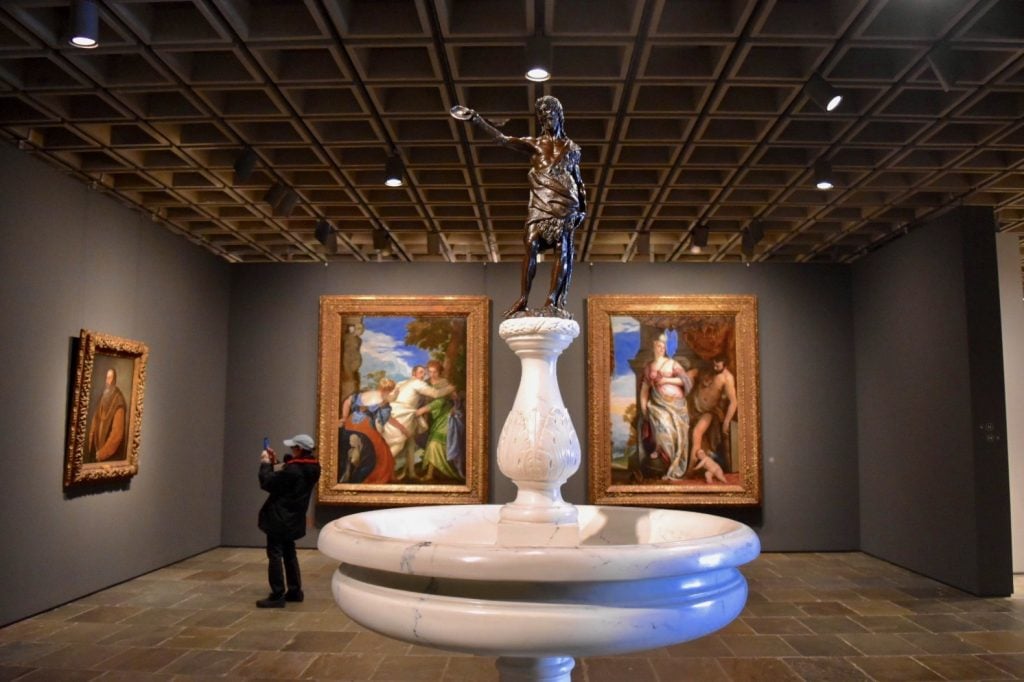
Francesco da Sangallo, St. John Baptizing and Giovan Francesco Pagni, holy water font, at the Frick Madison. Photo by Ben Davis.
Once, these artworks were part of living cultures, embedded in certain kinds of social worlds, with certain kinds of devotional functions. Relocated into the museum, they are estranged from their living contexts, becoming talismans in search of animating meaning, or viewed in a purely formal, decorative way.
Which is just a fancy way of saying: an individual visitor cannot shotgun 100-plus artworks and get that much out of them. In fact, that particular form of museum speedrun already reflects the modern mania for consuming images in bulk (i.e. the “decay of the aura”).
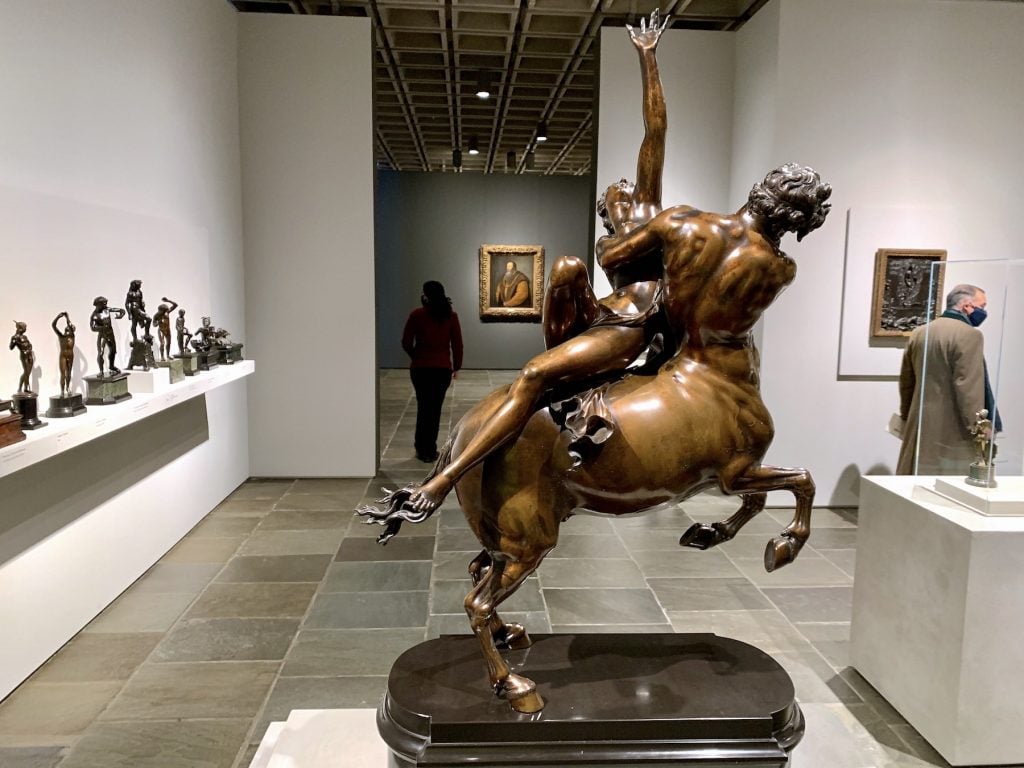
Attributed to Pietro Tacca, Nessus and Desianira at the Frick Madison. Photo by Ben Davis.
Well, in one way, that’s just the lot of contemporary art-goers, and the Frick Madison is certainly impressive enough on a casual walkthrough. But the best use of this art, in the age of the rootless digital image, is as training in the value of informed looking. Approaching it this way requires slowing your experience and homing in on the specifics of one or two things.
And so, I latched onto Duccio di Buoninsegna’s Temptation of Christ on the Mountain (1308–11), a tiny gem floating in the Medieval galleries at the Frick Madison, on the third floor—not a painting I knew a lot about before. Perhaps one just sees whatever narrative one is looking for, but as it turns out there’s a lot you can learn about how shifting contexts shaped art history from this little painting.
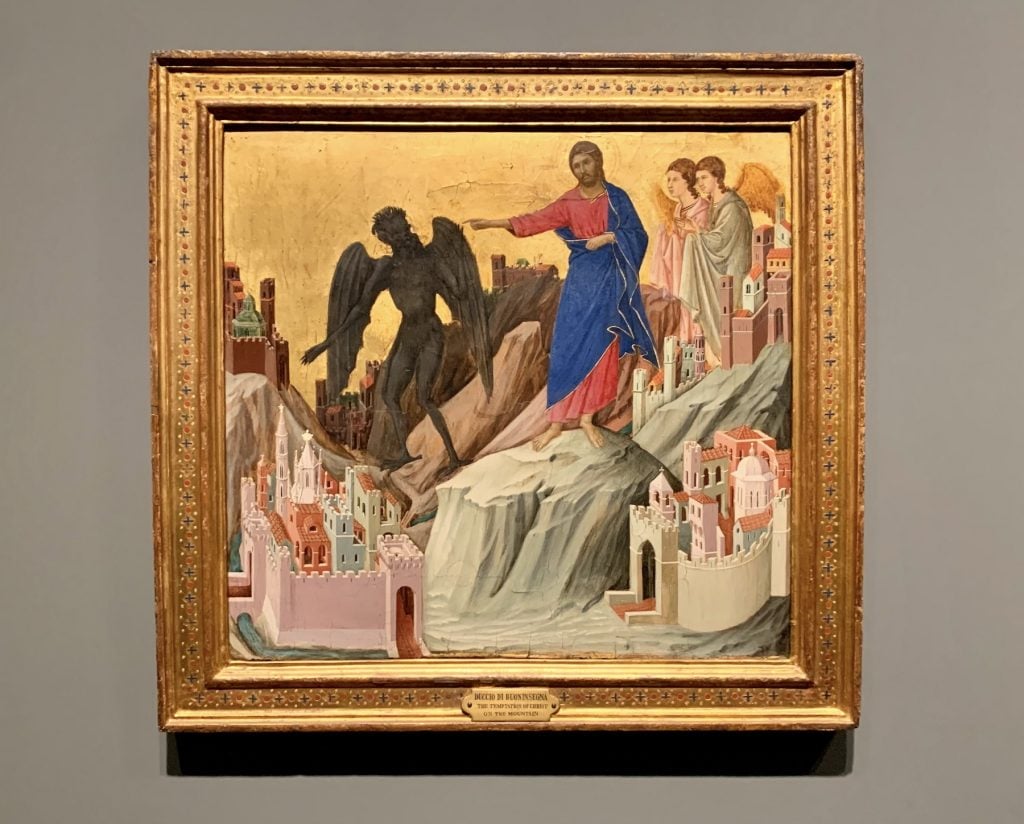
Duccio di Buoninsegna, Temptation of Christ on the Mountain (1308-11) at the Frick Madison. Photo by Ben Davis.
Duccio’s tempera-on-panel illustrates the moment of Christ’s temptation in the desert, from Matthew 4:8-11:
Again, the devil taketh him up into an exceeding high mountain, and sheweth him all the kingdoms of the world, and the glory of them;
And saith unto him, All these things will I give thee, if thou wilt fall down and worship me.
Then saith Jesus unto him, Get thee hence, Satan: for it is written, Thou shalt worship the Lord thy God, and him only shalt thou serve.
Then the devil leaveth him, and, behold, angels came and ministered unto him.
The painting depicts that moment of righteous resolve, of sacrificing the promise of power for principle. The gold-leaf sky and Christ’s blue robe—rendered with an expensive, and therefore symbolically important, pigment—suggest the sacredness of the subject matter.
As curator Keith Christiansen remarks in a text about Duccio, this small composition also happens to mark “one of the earliest and most evocative panoramic landscapes in early Italian painting.”
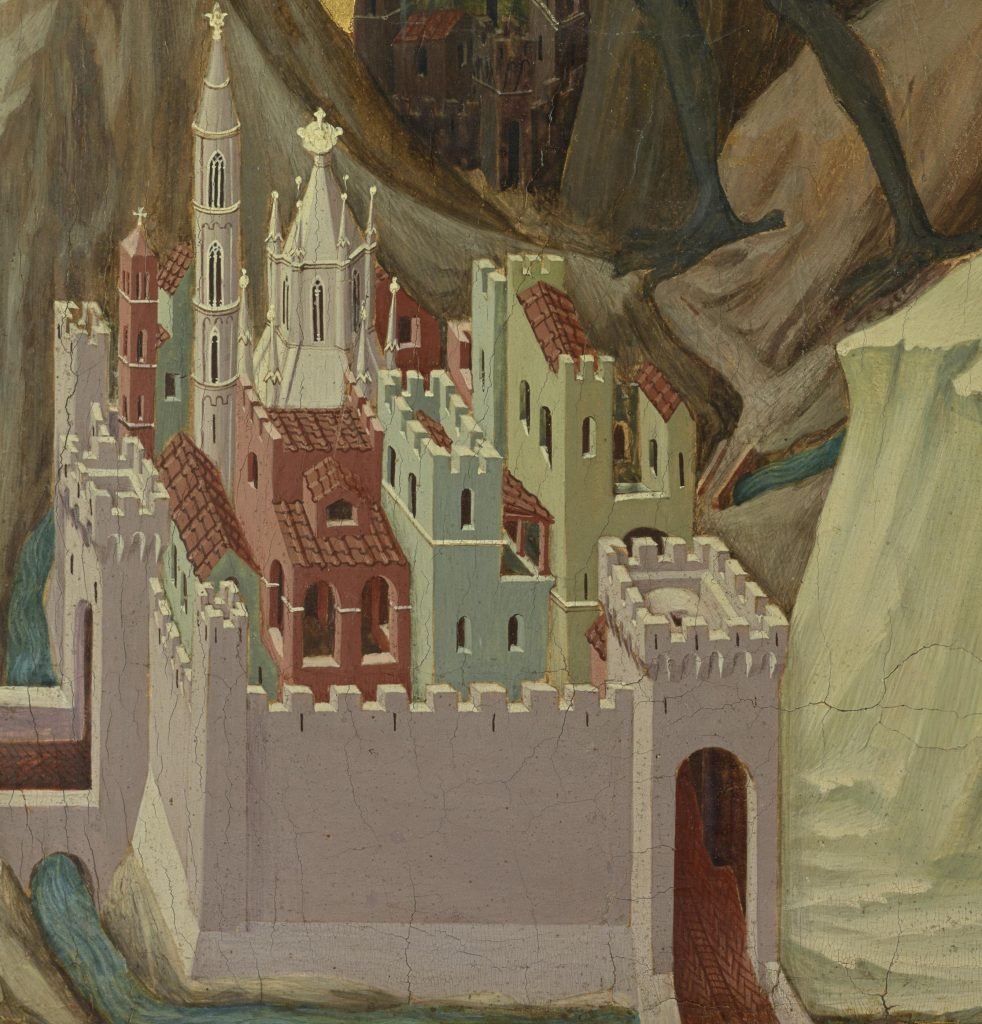
Detail of a castle in Duccio di Buoninsegna, Temptation of Christ on the Mountain (1308-11)
Arrayed on the earth around the central figures, all those intricate, toylike cities represent the glorious kingdoms being offered to Christ. You can see how the Medieval scale-shifts of Duccio’s image capture the oneiric sense of the confrontation described in the Bible passage better than a more realist, later depiction might.
Duccio is known as a bridge between the hieratic Byzantine “Greek style” and the more naturalistic glories of the later Italian Renaissance. You see his innovations in the clarity and serene realism of his Christ’s face.

Detail of Christ’s face in Duccio di Buoninsegna, Temptation of Christ on the Mountain (1308-11)
But Satan, clearly, is the star of the show. The Bible actually doesn’t give a lot of guidance on what Satan looks like. Like his contemporary, Dante, Duccio imagines him as a bat-winged character—bat wings signifying the demonic, as opposed to the bird wings of angels.
Bats, in the Medieval imagination, were also unsettling because they existed between mammals and birds, and they flew at evening, between the day and night. They represented the blurring of clear boundaries and the loss of clear knowledge.

Detail of the devil’s face in Duccio di Buoninsegna, Temptation of Christ on the Mountain (1308-11)
So, it’s actually a symbolic touch, in Duccio’s Temptation, how murky and unresolved the Devil’s features are, as opposed to the more clearly defined, radiant features of Jesus. Christ’s casting away of the Devil comes after a period of the Devil trying to confound him, so Duccio’s stylization of the Devil’s features suggests the specter of uncertainty that Christ is casting off, the drama of moral confusion versus moral clarity.
As for the angels watching from the sidelines—well, they look off to me.
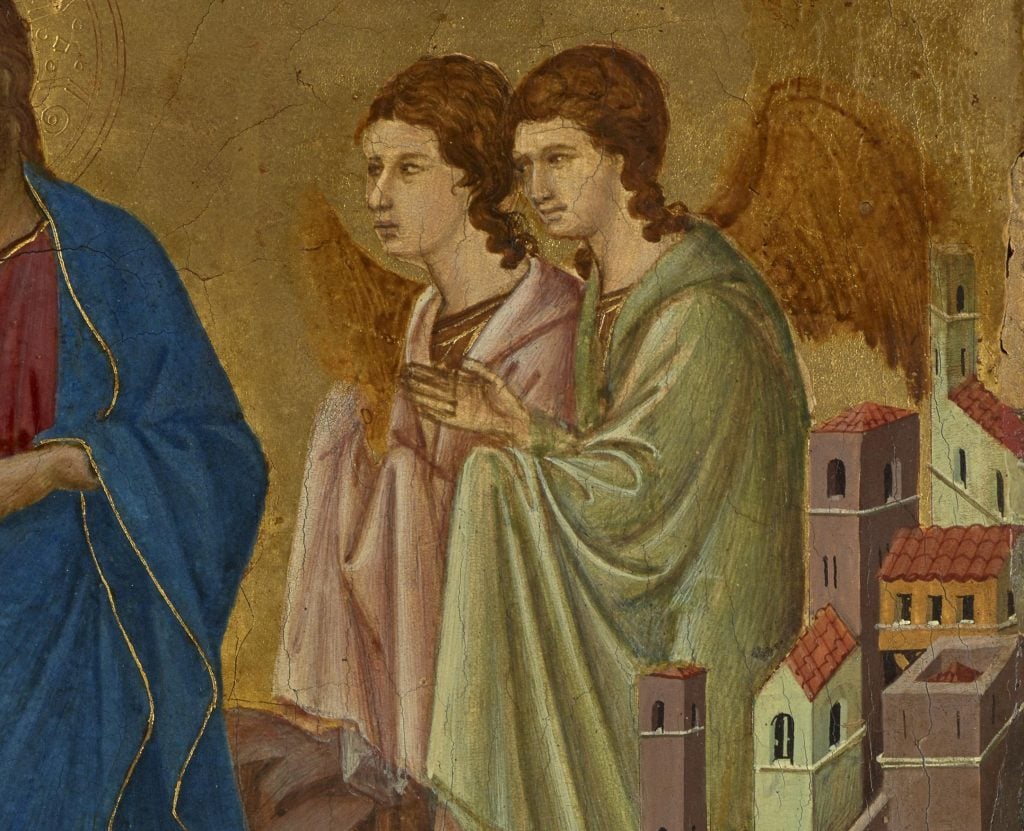
Detail of angels in Duccio di Buoninsegna, Temptation of Christ on the Mountain (1308-11)
As it turns out, the angels are not by Duccio. According to Christiansen, a busybody Sienese cleric had them added, thinking that the artist should really have mentioned the angels who came to speak to Christ after the key refusal, to make the image more triumphant.
Remove them from the composition, like so, and look how much better the whole thing looks, so much more clearly centered on the drama at hand and uncluttered.
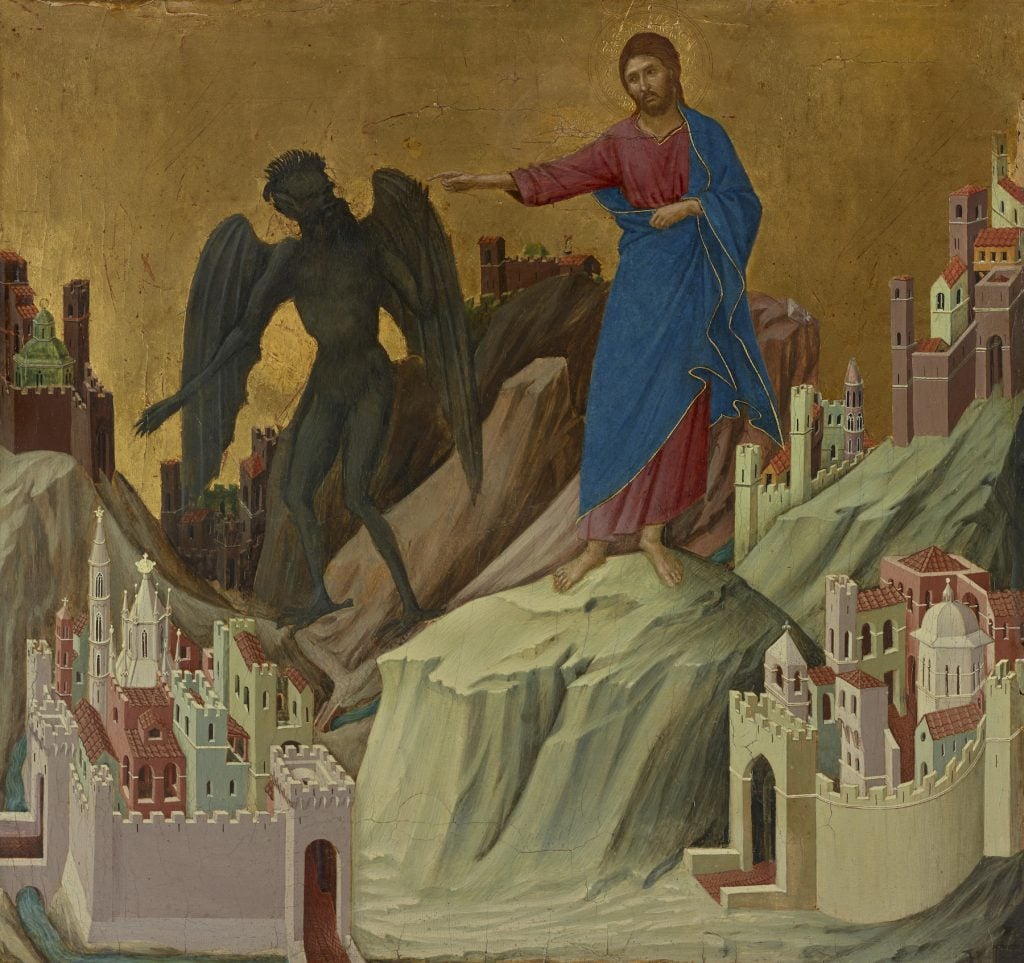
Duccio di Buoninsegna, Temptation of Christ on the Mountain (1308-11) with the angels removed via Photoshop. Editing by Taylor Dafoe.
It’s not unusual, in Medieval art, to layer different moments in time. But in the verses from the Book of Matthew, it is not until after the Devil departs that the angels arrive—and there is something a little more poignant about showing the moment of decision, the climax of the action, before it has been rewarded with a sign from Heaven’s emissaries.
I have to admit, I didn’t know a lot about Duccio before my visit to the Frick Madison. He’s not one of the more popularly worshipped Renaissance artists. History played a role in determining his status—actually the familiar twin forces of pandemic and misinformation.
Duccio was the dean of the Sienese School, his workshop spinning out a variety of other well-known artists who built on his style, such as Ambrogio Lorenzetti and Simone Martini. But a few decades after Duccio’s death, Siena was hard hit by the Black Plague in 1348. The once-thriving city-state lost between a third and a half of its population. It never recovered. Commerce shifted to rivals, including Florence.
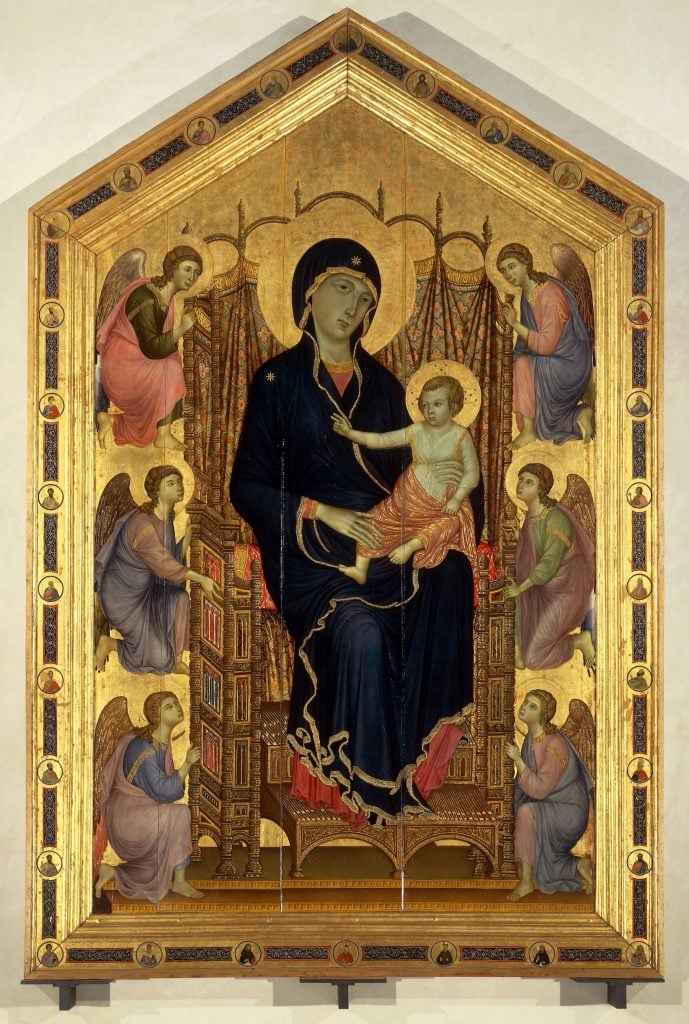
Duccio di Buoninsegna’s Madonna Rucellai (ca. 1285) in the Uffizi Galler. Photo by DeAgostini/Getty Images.
That shift had an impact that reshaped the canon. Vasari’s 1550 The Lives of the Artists created the discipline of art history and defined the hierarchy of Renaissance artists for later generations. Embedded in the Florentine art scene, Vasari was completely committed to Florence as the center of his drama. He botched Duccio’s “Life,” describing him as a younger, inferior pupil to the very artists he had taught, and ascribing one of his best works, the Rucellai Madonna, to the Florence-born Cimabue—a painter whom Vasari thought of as the first great innovator of the Renaissance.
Duccio’s fate as an art-historical character also shows how complete accidents have lasting impact that compound over time. In researching Sienese art, Vasari’s guide was the Florentine goldsmith Lorenzo Ghiberti’s 1447 Commentaries, in which he had described the subject of Duccio’s most important work as being a “Coronation of the Virgin.” But the central subject of the Maestà Altarpiece was no such thing; it depicts “Madonna Enthroned.” Vasari couldn’t find it on his visit. He missed the scale of Duccio’s achievement due to bad intel.
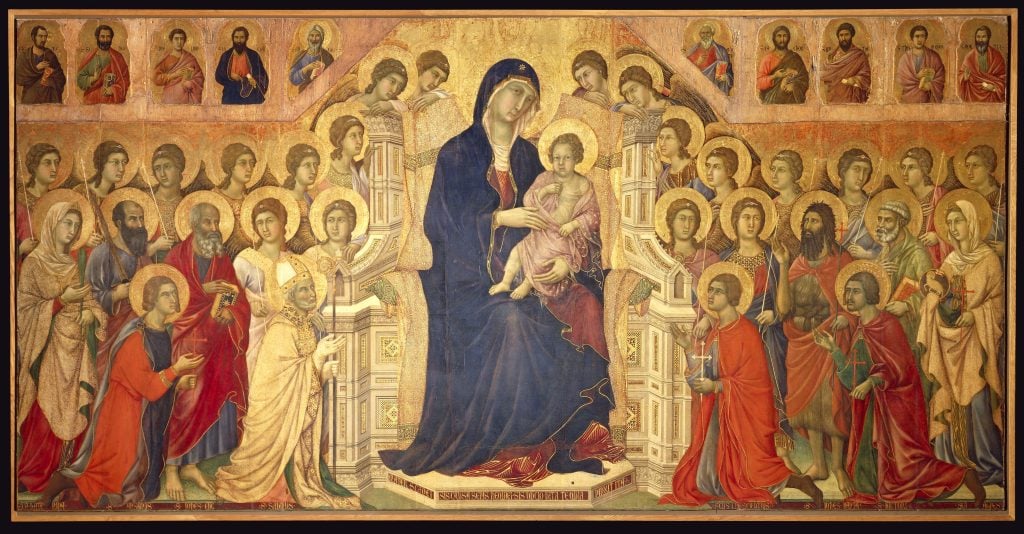
Virgin Enthroned with Child, surrounded by Angels and Saints, central panel of the Maestà Altapiece (1308-1311) by Duccio di Buoninsegna. Photo via Getty Images.
When Duccio created the Maestà Altarpiece for Siena Cathedral it was a huge civic event, and a breathtaking artistic achievement. The bulky, gilded work, with its involved cycle of images from the life of Christ, was long the subject of pilgrimages in Siena. But fashions change. By Vasari’s time, it was considered passé. Two centuries later still, in 1771, its caretakers decided to hack it into pieces, permanently disfiguring it, to be able to display both sides at once and also to sell off the smaller panels piecemeal—a very vivid example, now that I think of it, of what Walter Benjamin meant in describing the transition from devotional “cult” value to profane “exhibition” value.
The small panels, fragments of the original total statement that held the Cathedral’s center in its trecento heyday, entered the art market at a time when the political and economic revolutions in Europe led to a cultural transformation. Collecting the Italian Renaissance became the symbol of the rising bourgeoisie’s aspirations to replace the aristocracy, both in social status and in grandeur.
In the late 19th century, London merchant banker Robert H. Benson acquired four of the Duccio panels for £2,000 (the equivalent of about $370,000 now). One of these, originally located on the lower reverse of the Altarpiece, was Temptation of Christ on the Mountain. In 1927, famed art-dealing duo the Duveen Brothers acquired the Benson Collection, from which the Temptation was purchased for the Frick Collection at the initiative of Helen Frick, heiress of ruthless Gilded Age industrial tyrant Henry Clay Frick.
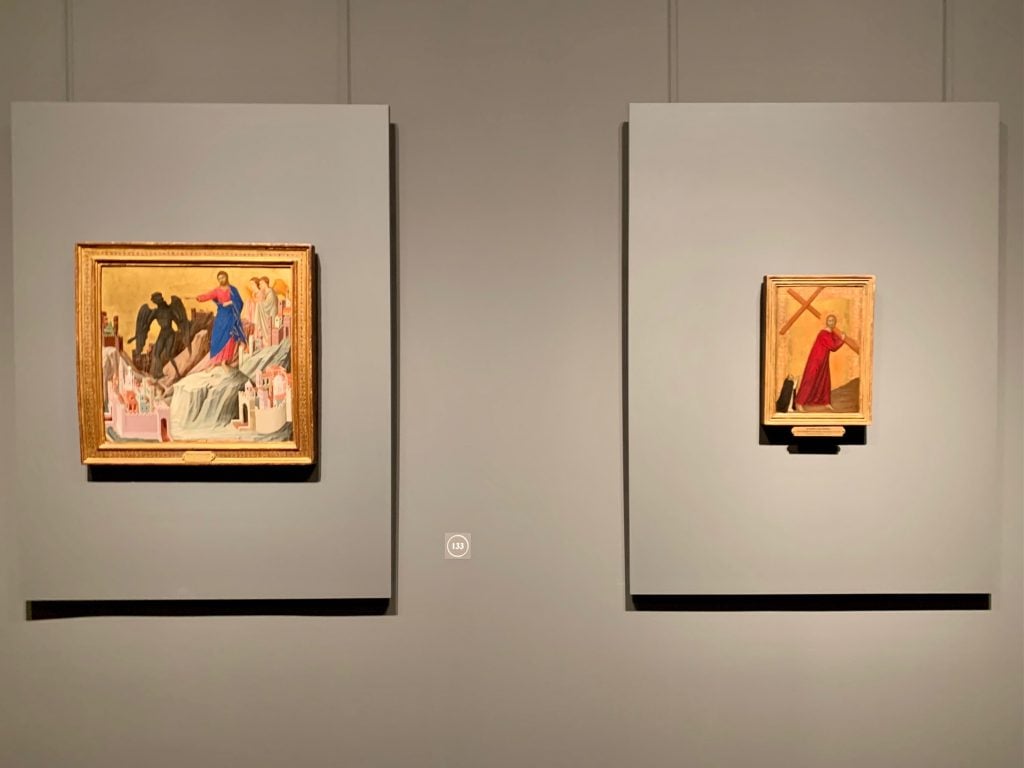
Installation view of the Medieval Galleries at the Frick Madison. Photo by Ben Davis.
And here we are, 90 years later, observing the panel’s latest context shift, even if it is a temporary one. Today, it is repurposed in the soothing, neutral gray space of the Breuer building as an icon in the church of Great Art, in the moment of tentative reopening and return to IRL art-viewing amid our own pandemic.
Is all this historical context necessary to enjoy the painting, or is it just a nice bonus to have? Personally, I feel that without it, all the art just becomes a blur of superficial qualities. And in a twist, it is the kind of interest in the object as the product of a past that activates it as an image that I can connect to in the present.
What is the figure of Duccio’s Christ to me, in 2021? The Devil offers all the glories of the world—which I will read as the power to experience all the images of history. But only on the Devil’s terms—and the Devil represents the blurring of meaning to indistinction, the decontextualization that miniaturizes all the histories of the world in bringing them into one space.
Christ rejects the offer. I’m going to read that as accepting a kind of humility in front of the art, the idea that to get the greater reward, you have to give up the sense that you can see it all in favor of some kind of devotion—to figuring out an image, a history, a culture, a way of looking.
![Dccio di Buoninsegna, Temptation of Christ on the Mountain (1308-11) [detail] at the Frick Madison. Photo by Ben Davis. Dccio di Buoninsegna, Temptation of Christ on the Mountain (1308-11) [detail] at the Frick Madison. Photo by Ben Davis.](https://news.artnet.com/app/news-upload/2021/03/Duccio-The-Temptation-of-Christ-on-the-Mountain-detail-1024x993.jpg)













